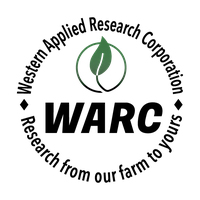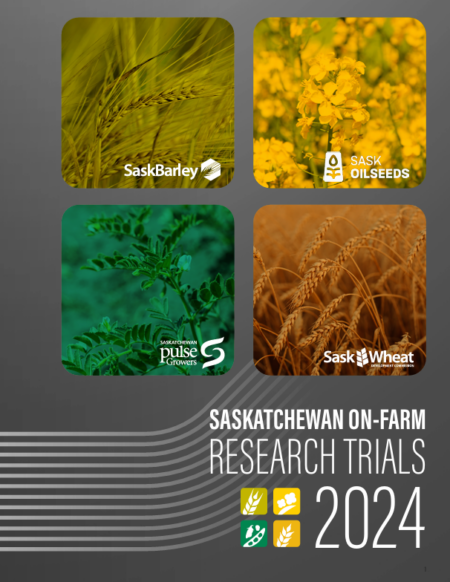 In 2024, SaskBarley expanded the BarleyBin Field Lab to three protocols with seven sites – up from one protocol with two sites in its inaugural year, 2023. These are the results of those on-farm research trials.
In 2024, SaskBarley expanded the BarleyBin Field Lab to three protocols with seven sites – up from one protocol with two sites in its inaugural year, 2023. These are the results of those on-farm research trials.
Protocol 1: Seeding Rates
Protocol 2: Nitrogen Fertility Rates
Protocol 3: Plant Growth Regulators
Protocol 1: Barley Seeding Rate Trial
The recommended seeding rate for malt barley is 300 live seeds/m2, which corresponds to a plant density in the range of approximately 20-22 plants/ft2. Researchers found that 300 live seeds/m2 optimized agronomics including yield and lodging, as well as malt characteristics including protein and plump kernels.
This protocol was first implemented in 2023 and the results for 2024 combine two years of data.
Objective
To optimize barley seeding rates based on target plant density to balance seed costs, yield, crop competitiveness and stand management.
2023-2024 Results
The combined results from 2023 and 2024 barley trials across multiple sites highlight the impact of seeding rates on plant density, seedling mortality, yield, and grain quality. In both years, increasing seeding rates significantly raised plant density (p<0.0001) and seedling mortality (p<0.0002 in 2023; p=0.017 in 2024). Despite higher mortality, variable seeding rates often resulted in competitive yields, though the low seeding rate consistently emerged as the most cost-effective option, producing insignificantly higher yields and better economic returns. Grain quality, particularly test weight, was highest with the standard seeding rate, followed by low and high rates. When data were grouped by plant density rather than seeding rates, significant trends were observed for plant density (p<0.0001) and plumps (p=0.0273), with standard seeding rates showing the greatest yield return (2.6 bu/ac increase) and profitability ($9/ac gain) when target densities were achieved. The findings emphasize the importance of precise seeder calibration, plant density monitoring, and adjustments based on thousand kernel weight, germination rates, and drill settings to optimize barley production. Overall, the low seeding rate appears economically favorable, but achieving target plant densities with standard rates can maximize yield and profitability.
View the results for Luseland, Major, Rosetown and Wilkie in the full report.
Protocol 2: Nitrogen Fertility Rates in Barley
Increasing applied fertilizer rates can increase barley yield and quality. Prairie soils are often deficient in nitrogen (N) and phosphorus (P). Some soils are also deficient in potassium (K), sulphur (S), and possibly one or more micronutrients. However, depending on the growing environment, genetics, and other management practices within the production system, increasing fertilizer rates may result in differing economic returns for each farm. Higher nitrogen fertilizer rates may also lead to increased crop lodging or decreased malting quality.
Objective
To quantify the agronomic and economic impact of increasing fertility rates on your farm under typical management.
2024 Results
Varying nitrogen rates had minimal impact on thousand kernel weights, test weights, protein levels, and germination rates. Although the relationship between yield and nitrogen rates approached significance, variability prevented it from being conclusive. The reduced nitrogen treatment yielded the highest return (not shown). The lack of a nitrogen response may be attributed to higher residual nitrogen levels found in spring soil samples, along with the narrow range of application rates (+/- 6 lb N/ac).
View the results for this trial at Plenty in the full report.
Protocol 3: Using Plant Growth Regulators (PGRs) in Barley Trial
The use of plant growth regulators (PGRs) in high-yielding and high-moisture areas can provide benefits by reducing lodging risk in cereals. Barley varieties have been shown to vary in their response to treatment with PGR trinexapac-ethyl (Moddus), and the response can also vary with growing conditions. PGR application can also impact barley yield and quality.
Objective
To quantify the agronomic and economic impact of PGR (Moddus) application on barley compared to an untreated check across various management, soil, and weather conditions.
2024 Results
The PGR full-rate treatment achieved the highest yield at 139 bu/ac, representing a 20 bu/ac increase over the untreated check. While yields increased, PGRs also resulted in lower test weights and fewer plump grains. The full rate provided the highest returns, benefiting from both the increased yield and that only one application was needed
View the results for this trial at Humboldt in the full report.
Want more field-scale research results?
Find more results from the Saskatchewan On-Farm Field Research program at our participating partners:
View the full report.
 Thank you to WARC for their roll in the organization, management and data analysis for the 2024 trials.
Thank you to WARC for their roll in the organization, management and data analysis for the 2024 trials.
Learn more: On-Farm Research – Western Applied Research Corporation

